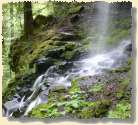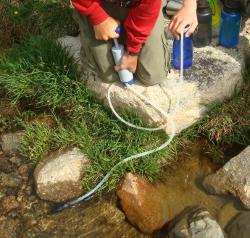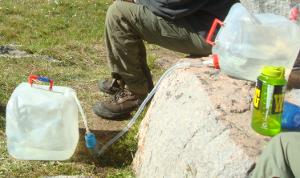
Hiking Water Treatment
Making Water Safe
 As a boy, I lived in the mountains and ran around with my brother and dogs all summer. When we got thirsty, we'd drink right from any old creek we happened to be passing. This was clear, cold, mountain water - refreshing and crisp. Now, I can't recall the last time I drank right from a stream as an adult. Water is always treated in some manner before drinking because I've been educated to the fact that even clear mountain water might have bad stuff in it.
As a boy, I lived in the mountains and ran around with my brother and dogs all summer. When we got thirsty, we'd drink right from any old creek we happened to be passing. This was clear, cold, mountain water - refreshing and crisp. Now, I can't recall the last time I drank right from a stream as an adult. Water is always treated in some manner before drinking because I've been educated to the fact that even clear mountain water might have bad stuff in it.
Just as each person has a unique need for water, each person's body can handle contaminated water differently. To be safe, treating all water while out hiking is your best bet. You may drink untreated water from a dozen streams and be ok, but then again, you might not be so lucky.
Water can be treated many different ways in the wild. If you ask around, you'll find that people are very opinionated about the Best method for making water potable.
 Filtering - water passes through an element which catches small particles and allows the water to pass on. The pore size in the element determines what gets filtered out of the water.
Filtering - water passes through an element which catches small particles and allows the water to pass on. The pore size in the element determines what gets filtered out of the water.
If you poured water through a piece of tent screen, it would catch sticks and sand, but that's about it. Pouring it through a bandana would catch more dirt and small bugs. Pouring through a paper coffee filter would catch even more.
These are all just capturing visible contaminants, though. The ones we are really worried about are the cysts, bacteria, and viruses that are too small to be seen. To capture these, commercial water filters or purifiers are needed.
There are two main types of water filters now available for field use on outdoors hikes.- Pump Filters - one end of a hose is placed in the water supply and the other end in your water container. When the pump handle is operated, water is forced through the filter element. This takes time and effort, but is a very popular method of filtering.
 Gravity Filters - water is gathered in a dirty container and placed at a high point. The container has an outlet tube through which water flows down into the filter element and out into a waiting clean container. This method takes little effort since gravity is doing the work. While filtering water, you can tend to other chores.
Gravity Filters - water is gathered in a dirty container and placed at a high point. The container has an outlet tube through which water flows down into the filter element and out into a waiting clean container. This method takes little effort since gravity is doing the work. While filtering water, you can tend to other chores.
 UV Light - a relatively new way to treat water.
UV Light - a relatively new way to treat water.
A small device bombards the organisms in the water with ultraviolet light destroying their reproductive abilities. This method is fast, inexpensive, and lightweight.
It does require care with the device and extra batteries.- Chemical Treatment - water is collected and a few drops of chemicals are added. The chemicals kill all organisms in the water. This method is easy, but takes time and tends to be more expensive overall. It is very lightweight since you carry no mechanical device. It does leave all the dead organisms in the water that you drink.
For details on water pollution and treatment visit Water Filter Dude.
All Comments:
Apr 13, 2013 - Andrea
Apr 14, 2013 - Hiking Dude
Apr 05, 2014 - Steve
Apr 06, 2014 - Hiking Dude
Jul 26, 2014 - Jesse
Jul 26, 2014 - Hiking Dude
Aug 05, 2014 - doghiker
Aug 07, 2014 - Hiking Dude
Aug 11, 2014 - Bob Hanes
Aug 11, 2014 - Hiking Dude
Sep 05, 2014 - dena
Apr 03, 2015 - Ken
Jun 21, 2015 - Rkaid
Jul 15, 2015 - jimj
Jul 19, 2015 - Hiking Dude
Ask a Question
Find more Hiking Resources at www.HikingDude.com


 Carrying your Water
Carrying your Water Planning your Food
Planning your Food
Follow Me
Recent Comments